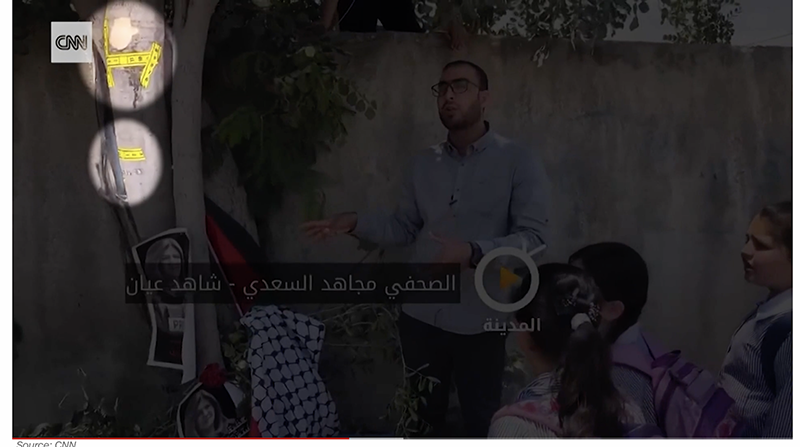A Rebutal to Bellingcat, AP, CNN, and Even Elder of Ziyon By Reader Jon
Like many people in Israel, I woke up on May 11 to the news about the shootout in Jenin, and that journalist Shireen Abu Aqleh had been killed. It quickly became apparent that this was yet another incident in which Israel would immediately be blamed for her death, even as evidence emerged that showed she was killed in unclear circumstances.
Recently, pro-Israel blogger Elder of Ziyon uploaded a post in which he explained his belief that it was most likely IDF fire that killed Abu Akleh – though he clearly believed it was accidental. His post follows reports from Bellingcat, AP, and CNN which all made a similar determination, though in their cases the reports also gave credence to the idea that Israel deliberately targeted her.
I decided to write this because all of those reports, and even Elder’s own post, continue to omit important evidence, chief among them an additional position with Palestinian fighters, but also becuase these reports fail to critically examine the evidence and the ways it contradicts their own narrative. I felt especially motivated to write something after the particularly egregious CNN report, which mixes dangerous dishonesty with profound incompetence in equal measure.
I want to show two things with this post:
- The available evidence casts serious doubts on the idea that the IDF fired the shots that killed Abu Aqleh.
- I believe the available evidence almost certainly disproves the idea that she was targeted deliberately, even if it was an IDF bullet that killed her.
I think there are five factors that need to be considered, so I’ll go through each of them.
The Additional Palestinian Gunmen
So far, none of the reports that have analyzed the shooting have included an additional group of gunmen that were clearly identified the day of the incident. They can be seen clearly in this video (which was later taken down from social media). They were located ~150 meters from Abu Aqleh across the (mostly) open area of the cemetery. The position can be seen in this map, which is by far the most complete I’ve been able to find (Credit to @geoliticsworld):

In their report, CNN shows this map and claims that “the only recorded positions of Palestinian militants” were south of the IDF.

Their claim can be disproved in just a few minutes, showing that they are either lying or they’re incompetent. Possibly both since there are multiple writers credited for the post.
Regarding the gunmen, could they have been responsible for the shooting? Potentially.
There is a question of line of sight, which I simply don’t have evidence for. However in this photo from the scene, it seems that the wall across from where Abu Aqleh was shot is not high enough to completely screen someone walking in that area.

Keep in mind that the area with armed Palestinians I identified is further south, and therefore uphill. So it’s possible the elevation could make the area where Abu Aqleh was shot more visible. Additionally, the bullet holes in the tree appear to be potentially consistent with shots fired diagonally from the southeast.
I have been extremely curious about the possibility that Palestinian gunmen could have mistaken Abu Aqleh and her team for IDF soldiers. If they saw helmets just above the wall, from the side, through the brush, it could be easy to mistake them for soldiers.
It would also go a long way to explain the rapid fire nature of the shots aimed at the journalists, and that also brings up the second point.
Rapid Fire Shooting and a Pause
The reports that suggest the IDF was responsible provide as evidence the clear line of sight between the IDF position and the journalists. But, as CNN points out, several bystanders were standing on that corner for several minutes milling about in clear view of the IDF until the journalists started walking up the road. No shots were fired.
Here is a direct quote from CNNs report:
“We stood in front of the Israeli military vehicles for about five to ten minutes before we made moves to ensure they saw us. And this is a habit of ours as journalists, we move as a group and we stand in front of them so they know we are journalists, and then we start moving.”
Let’s entertain their theory for a moment that the IDF targeted Abu Aqleh. Imagine an IDF soldier wants to kill her. He waits, staring at them for 5 to 10 minutes, and then once they are 5 or 10 meters closer and he chooses to fire, he unloads with a burst of six shots in 2.8 seconds and then a second burst of seven shots in 2.5 seconds.
You can call that many things, but precise fire it is not. I admit the possibility that this rapid fire could have come from the IDF, but the idea that such rapid fire is evidence of targeting is nonsensical.
Also, the pause between the two bursts is odd. In the videos there is a pretty clear line of sight between the IDF vehicle and the journalists. Later on, one of the journalists is seen taking cover behind a bush or tree – Abu Aqleh is seen lying on the ground. But in the video before the shooting, there are at least three or four people walking in the middle of the road several meters from that tree.
The time between the two bursts is nine seconds. Where were they taking cover those nine seconds? Is it possible that they ducked down, below the level of the wall screening fire to the southeast, and then when the firing stopped got back up and exposed themselves to the same source of fire?
Additionally, when the second burst happens, there are seven shots in ~2.5 seconds. Seven shots. The idea of this being targeted, or as Bellingcat tried to assert “slow and deliberate,” is absurd.
Additional evidence against targeting is the wide grouping of shots that CNN and others show in their reports. With an M4 or M16 style weapon, it’s possible to achieve close to 1 or 2 MOA at 100 meters. This is a measure of accuracy that would produce a group of shots within one or two inches of each other at a distance of 100 meters. At 200 meters that would be closer to 2-4 inches. Now, that level of accuracy is usually achieved on the range, and not necessarily in combat but the group of bullet holes shown in the video is way more than even might be expected from combat accuracy. It’s a wide group, showing very low precision firing – which again directly contradicts the idea this was a sniper or even an IDF marksman.

In this screengrab from CNNs video, there appears to be around 18 inches between these two shots. To get a sense of the accuracy that can be achieved with an M4 with targeted fire and a scope (which would be available to an IDF marksman) from 200 meters you can see this video:
Or this video where they only use iron sights:
According to the targeting theory, an IDF sniper or marksman, from the safety of a rooftop or armored vehicle, waits several minutes with a clear view of the journalists, and then when he does fire, his shots are so inaccurate they produce the wild group as seen in CNNs video.
But here is something that I can not imagine an explanation for. CNN and the Palestinians claim that the IDF targeted her, or even more absurdly assassinated her. They claim that she was shot by an Israeli sniper, that the shot was so precise as to hit the small area between her helmet and neck. But they would also have us believe that this same sniper, just 200 meters away who is deliberately targeting Abu Aqleh, fired 13 shots and only registered two hits – one on Abu Aqleh, the other on her colleague. If this is true, then Israel has way bigger problems than bad PR, it also has the world’s most incompetent army.
An Open Question About Distance
All the reports have featured forensic experts explaining that the time difference between the snap and pop sounds in the video suggests that the shots came from about 170-190 meters away. However, I wonder if they are determining the distance between the shooter and the camera or the shooter and Abu Aqleh – because those two things are NOT the same thing.
The two videos that record the shots were both filmed at this approximate location:

However, the distance between the cameraman and the known IDF position is closer to 215 meters not 197 and not certainly not 177 which CNN provided as it’s lower estimate of the distance between Abu Aqleh and the shooter.
But, that distance does correspond to the position of armed Palestinians that all of the reports continue to ignore. Those armed men were in an area roughly 170-180 meters from the two videos.
Different Fighting and Firing Styles
I think I’m giving too much credit to the armed Palestinians in Jenin that day and to the various Palestinian armed groups, but it’s important to contrast evidence of the IDFs firing behaviour with that of the Palestinians.
There are two examples of the IDF operating in Jenin that day that clearly show them firing. The first is the body cam footage the IDF shared, which showed them operating in a calm and controlled manner, firing limited shots, all while taking tremendous incoming fire.
The second is this video in which you can see IDF soldiers firing single controlled shots. Note that they are firing 90 degrees in the other direction from Abu Aqleh in the direction of the documented positions of Palestinian fighters.
Contrast this firing style with the videos of Palestinians firing. There is of course this famous example of the video the IDF shared the same day of a Palestinian fighter shooting wildly around a corner.
You can also see this recent propaganda video from PIJ showing their fighting style which can best be described as “blindly shoot around corners” in rapid bursts. Or this one. This would fit more closely that pattern of shots that appear to have struck Abu Akleh.
Absence of Evidence is Not Evidence of Absence
The biggest problem with all of these reports, with Elder’s post, and even my own analysis is that they try to present a complete picture of the area and the firefight that took place there.
I’ve already shown that all the reports fail to include a well documented position of armed men, they also fail to mention Palestian shooters on balconies and rooftops, an example of which can be seen here.
But beyond that, these videos only capture very brief, very narrow, and very incomplete moments in time. The IDF has said that Abu Aqleh may have been shot in an exchange of fire between its soldiers and an armed terrorist near her position.
The witnesses dispute this, saying there were no armed men nearby, but it seems clear they mean there weren’t any terrorists they could see. The problem with that is that they could only see a very limited area. There could easily have been an armed fighter in multiple locations between the IDF and Abu Akleh. For instance, it wouldn’t have been difficult for the armed men I identified earlier to move down the road to a position between the IDF and Abu Akleh.
In fact, there is already evidence that that area between the IDF and Abu Akleh was accessed by other Palestinians because we have video of it. This video, which I showed previously, was filmed in a location between the IDF and where Abu Akleh was shot, near the blue rectangle in this map.

It seems to be filmed from behind the cemetery wall through a hole.
I've geolocated this video uploaded 6 hours ago to tiktok showing IDF troops in Jenin including clear muzzle flashes.
— Moshe Schwartz (@YWNReporter) May 11, 2022
📍 The location of the gunfire by IDF forces in this video is 32.461904,35.283381 and not in the direction of the killed journalist.
Thread https://t.co/L4HwTKflP0 pic.twitter.com/Um50etslHQ
If this cameraman was there, it’s logical that an armed fighter could have reached the same area and that could have been the one the IDF was shooting at. It at the very least shows the dynamic nature of the area, and how people were moving around even if they weren’t captured on video.
None of what I present here paints a conclusive picture; I won’t even attempt to say that. All I want to do is to highlight the gaping holes in the reports and narratives that have been presented by biased media outlets.
These reports rely on limited and incomplete evidence, questionable witness testimony, and obviously ignorant sources who continue with absurd claims. Just look at the CNN report, it mentions the word sniper six times and the way it’s used makes it clear the authors have no clue what a sniper is, how they operate or what equipment they use. That alone is enough to question the integrity of the entire report.
I have faith that, eventually, the IDF will present information that will paint a clearer picture of what happened that day. I might not like the evidence they present, but I believe they will provide much needed details that are currently lacking.



